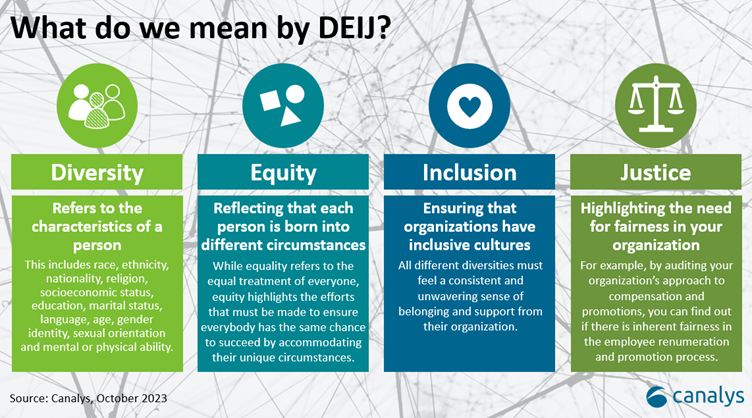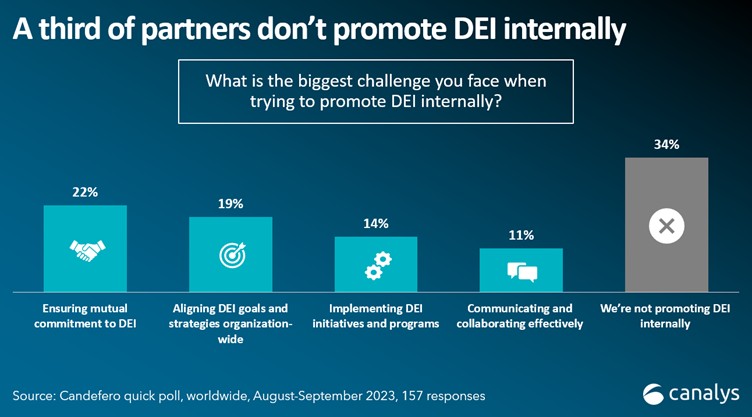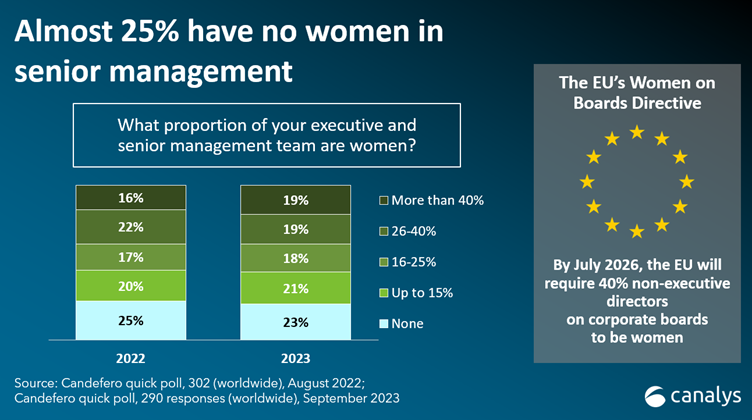AI’s evolving ecosystem: takeaways from the Dreamforce and Ray Summit AI conferences
30 October 2023
Canalys is part of Informa PLC
This site is operated by a business or businesses owned by Informa PLC and all copyright resides with them. Informa PLC’s registered office is 5 Howick Place, London SW1P 1WG. Registered in England and Wales. Number 8860726.

In early October, the Canalys Channel Forum kicked off in Barcelona. Diversity, equity, inclusion, and justice (DEIJ) were key topics – here’s what we covered.

On Wednesday 4 October, 20+ individuals from Lenovo, Schneider Electric, Bell Integration, Channel Edge, SonicWall and Trustmarque Solutions gathered to workshop concrete actions to promote DEIJ in the channel.
Why? Well, Canalys research shows that approximately a third of the channel are not doing anything to embed DEIJ into their organizations (Canalys Poll, August-September 2023).
Almost 40% of partners don’t believe they face any DEIJ challenges, and yet, 24% don’t have a single woman in their senior management (ibid, 2023).
And gender identity is just one form of diversity.
So, if we are failing to promote gender diversity, how else are we failing to include other social groups in the channel?

You cannot improve on what you don’t measure.
However, it isn’t always legal to gather data on the diversity of your employees.
So, many organizations are turning to surveys in which employees self-disclose information.
This is the advice from attendees:
Firstly, ensure the survey is genuinely anonymous.
Secondly, before sending a request for self-disclose, explore if your employees feel psychologically safe enough to self-disclose. Otherwise, your data will be erroneous.
- Psychological safety is the absence of interpersonal fear, the perceived ability to speak up about fears, concerns, or disagreements, without fearing negative repercussions.
Finally, ensure your leadership has committed resources to follow up on the results.
- Meaning, if employees self-disclose private information, and they don’t see any follow-up from the company with committed resources, all trust in this initiative will be eroded.

It is increasingly common for companies to set gender equality targets.
However, companies that are moving the needle on DEIJ are going beyond gender.
These companies seek to increase the representation and inclusivity of people based on factors such as race, national identity, socioeconomic background, LGBTQIA+ status, disability, and other factors.
The message here is; be bold and specific in your long-term DEIJ targets – and include short and medium-term targets to ensure accountability.
It can be particularly helpful to tie executive bonuses/KPIs to the achievement of these DEIJ targets – creating a sense of accountability and ownership.
A truly flexible work culture is key to attracting a diverse talent pool.
This includes flexibility on location and working hours.
Of course, meetings must be attended, and deadlines met.
However, when you are designing the role, ask yourself if the parameters of the role are really encouraging diverse talent to apply.
For instance:
Does the job in question require a lot of international travel?
Consider offering a job-sharing scheme and investing in childcare support.
Trying to mandate in-office work for a select number of days a week? Some employers are doing so. However, know that this lack of flexibility will impact those who choose to apply for the role.
Trust and open communication must be at the heart of your working culture.

Many HR leaders claim their talent pipeline is not diverse enough.
You must ask yourself; is your company diversifying the means, channels, and locations it uses to advertise roles, and brand itself as a company?
It is not enough to post a job advertisement and hope for the best.
If your recruitment team is in-house, remember to scan your job advertisements for biased language - software tools can help you do so.
Implement a blind application process – meaning a person’s CV contains no personally identifiable information before it is reviewed by a human being.
When it comes to the interview process, ensure those conducting the interviews are representative of the diverse workforce you would like.
If you are not in a position to offer that diversity, gather outside input during this process.
There are also organizations that specialize in sourcing diverse talent. These can be found if you peruse your chosen search engine.
Audits, performed by a third party, are a fantastic, and concrete place to start.
They will typically examine pay and promotions – to understand where inequities exist.
In turn, explore Supplier Diversity Programs – can your procurement team set requirements to procure services/products from more diverse companies?
Whistleblowing – ensure you have a separate third party managing a whistle-blowing service. Employees must be aware, and C-Suite must be regularly briefed.
Launch, fund, and support Employee Resource Groups – centering around any topic your employees choose – that can be gender, race, LGBTQIA+, veterans or others.
Ensure these networks are given the resources to succeed – don’t rely on these individuals to self-organize on top of a full-time role.
Most importantly, ensure the ERGs report to the C-Suite on a regular basis – and the C-Suite/Board should report back to the ERGs on how they are embedding this feedback.
Inclusive leadership and unconscious bias training are notoriously complicated.
It can be launched, but ensure it is part of a wider leadership development program.
Two-way mentoring – where junior employees mentor, and are mentored by, more senior team members, provides an interesting framework for knowledge-sharing and networking.
Remember to periodically gather DEIJ data, and report on it – internally and externally.
Finally, exit interviews provide gold: reach out to former employees – ensure a third party assists you in doing so, so you can glean the most honest feedback you require.

This topic will be explored in more depth at the Canalys Forum in North America on 13-15 November 2023 and at the APAC event in Bangkok on 5-7 December 2023.
Vendor and channel partners can get in touch to find out more about attending these events and learn more (spaces and sponsorships are now limited!)